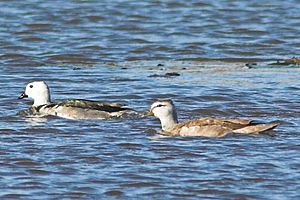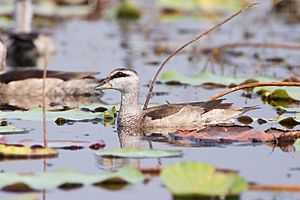Cotton pygmy goose facts for kids
Quick facts for kids Cotton pygmy goose |
|
|---|---|
 |
|
| Male (left) followed by a female, race albipennis | |
| Conservation status | |
| Scientific classification | |
| Genus: |
Nettapus
|
| Species: |
coromandelianus
|
| Subspecies | |
|
|
 |
|
The cotton pygmy goose (Nettapus coromandelianus) is a very small type of perching duck. It lives in parts of Asia, Southeast Asia, and even Queensland, Australia. In Australia, people sometimes call it the white-quilled pygmy goose.
These birds are among the smallest waterfowl in the world. You can find them in small or large bodies of water. They like places with lots of water plants. They usually live in pairs or small groups. They often rest and build their nests in trees near water. Cotton pygmy geese are strong fliers. They can travel long distances, especially during winter. Their breeding season starts when the rainy season begins.
What Does It Look Like?
Some of these birds are the smallest waterfowl on Earth. They can weigh as little as 160 g (5.6 oz). They can be as short as 26 cm (10 in) long. Their bill, which is like a goose's, is short and thick at the bottom.
Male cotton pygmy geese have a dark brown forehead and a blackish-green band around their neck. The sides of their head and neck are whitish. Their back and wings are dark brown with shiny green and purple colors.
Female birds have a duller cap on their head. They also have a brown line through their eye. Instead of a neck band, females have spots and fine lines on their face and neck.
When males are not breeding (this is called "eclipse" plumage), they look more like females. But they still have a wider white band on their wings. When flying, males have dark wings with white feathers that have black tips. Females have dark wings with a white edge on the back part of their wings.
Both males and females have red eyes and black legs. Breeding males might have greenish legs. Their bill is black.
Baby cotton pygmy geese (chicks) have white stripes above their eyes. These stripes meet at the back of their black head. They have a short dark stripe through their whitish face. Their neck is grey on top. Their back is grey-brown with two white patches on their shoulders. Their tail is dark grey or black. Their underside is a light yellowish-brown color.
Where Do They Live?
Cotton pygmy geese are found across a large area. This includes Asia and Australia. They move around depending on rainfall and how much water is available. Some groups travel further in summer. For example, they are only found in Afghanistan during certain seasons. In winter, they also spread out widely. They have been seen as far west as Arabia and Jordan. They are also regularly found on islands like the Maldives.
They especially like lakes and ponds with plants growing out of the water. They find their food among these plants. You can even see them in small village ponds in South Asia. In Australia, they mostly live in lagoons. They are known to rest in trees.
How Do They Behave?
Many pairs of cotton pygmy geese might look for food close to each other in the same body of water. In winter, they can form very large groups. One group of almost 6,000 birds was seen at Chilika Lake in India.
These birds mainly eat food from the surface of the water. Scientists have studied their stomachs. They found that these geese eat small fish, snails, crabs, and insect larvae. They also eat parts of water plants. They do not dive underwater or tip upside down to feed.
They can fly up from the water's surface very quickly. They don't need to run or flap their feet on the water first. They fly fast, often low over the water. They are quick enough to escape from falcons.
Their courtship dances are not well known. But after mating, the male will arch his neck. He shows off his white neck feathers and white wing patches.
They find a mate during the breeding season. This is mostly during the rainy season. In India, it's from June to August. In Australia, it's from January to March. They build their nests mainly in natural holes in trees. This could be inside tree trunks. Males help find nest spots. But the female usually does all the incubating (sitting on the eggs). She lays 6 to 12 ivory-colored eggs at a time. The nest can be as high as five meters (about 16 feet) from the ground. When the chicks hatch, they leap out of the nest to follow their parents into the water. Sometimes, more eggs are found in a nest than one female could lay. This might happen if other females secretly lay their eggs in the same nest.
Sometimes, rock pythons have been seen eating cotton pygmy geese. These birds can also get tiny parasites.
In Culture
In the past, especially during British rule in India, people hunted these birds. Their eggs were also collected for food. In the 1800s, many of these birds were sold in markets in Calcutta (now Kolkata). Fishermen in the Sundarbans used tall nets to catch them. They would scare the birds into flying into the nets. If a bird was hurt, it might dive underwater and hide. It would only leave its head or bill out of the water.
In Burma (now Myanmar), some birds have even nested inside buildings. One nest was found very high up, about 68 ft (21 m), under the roof of the governor's house in Yangon.
The Sinhala name for this bird is mal saar. This means "flower teal." It probably refers to their colors and how they live in ponds covered with lily pads. Many local names for the bird sound like its call. The name "cotton teal" was used by Europeans. They noticed the bird had a lot of white feathers.
These birds make a low, quacky sound. Some people describe it as "quacky duck, quacky duck."
See also
 In Spanish: Gansito asiático para niños
In Spanish: Gansito asiático para niños





